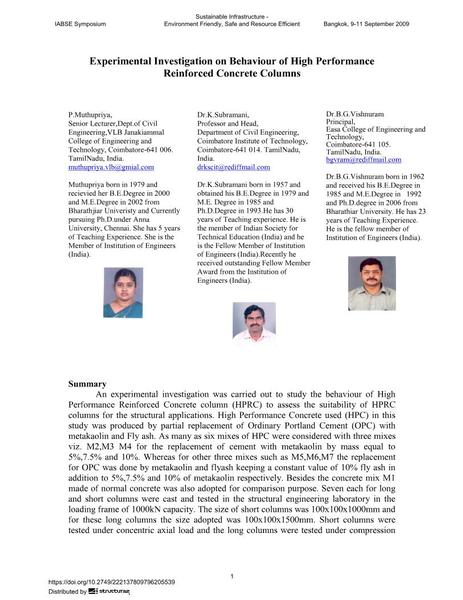Experimental Investigation on Behaviour of High Performance Reinforced Concrete Columns

|
|
|||||||||||
Bibliographic Details
| Author(s): |
P. Muthupriya
K. Subramani B. G. Vishnuram |
||||
|---|---|---|---|---|---|
| Medium: | conference paper | ||||
| Language(s): | English | ||||
| Conference: | IABSE Symposium: Sustainable Infrastructure - Environment Friendly, Safe and Resource Efficient, Bangkok, Thailand, 9-11 September 2009 | ||||
| Published in: | IABSE Symposium Bangkok 2009 | ||||
|
|||||
| Page(s): | 109-126 | ||||
| Total no. of pages: | 16 | ||||
| Year: | 2009 | ||||
| DOI: | 10.2749/222137809796205539 | ||||
| Abstract: |
An experimental investigation was carried out to study the behaviour of High Performance Reinforced Concrete column (HPRC) to assess the suitability of HPRC columns for the structural applications. High Performance Concrete used (HPC) in this study was produced by partial replacement of Ordinary Portland Cement (OPC) with metakaolin and Fly ash. As many as six mixes of HPC were considered with three mixes viz. M2,M3 M4 for the replacement of cement with metakaolin by mass equal to 5%,7.5% and 10%. Whereas for other three mixes such as M5,M6,M7 the replacement for OPC was done by metakaolin and flyash keeping a constant value of 10% fly ash in addition to 5%,7.5% and 10% of metakaolin respectively. Besides the concrete mix M1 made of normal concrete was also adopted for comparison purpose. Seven each for long and short columns were cast and tested in the structural engineering laboratory in the loading frame of 1000kN capacity. The size of short columns was 100x100x1000mm and for these long columns the size adopted was 100x100x1500mm. Short columns were tested under concentric axial load and the long columns were tested under compression and uniaxial bending with minimum eccentricity. The failure of short columns were prematured and showed high brittleness whereas in the case of long columns there were good buckling effect but the failure concentrated either at column head portion or at the base due to spalling of concrete accompanied with heavy cracks. The performance of short columns was studied by evaluation of ductility index and stiffness whereas for long columns ductility was obtained from load versus deflection curves and moment curvature curves. It was observed that the behaviour of HPRC columns was marginally better than those of normal concrete. Of course, from the literature survey it was learnt that high performance reinforced concrete columns require closer spacing of lateral ties or else confinement externally for enhanced performance. Besides the companion specimens such as cubes, cylinders and prism beams were also cast and tested to study the strength characteristics such as compressive strength, split tensile strength and flexural strength of HPC mixes adopted in this study. There is a good increase for all the above mentioned strength for HPC mixes adopted in this study. |
||||
| Keywords: |
HPC fly ash metakaolin high performance reinforced concrete columns ductility index and ductility parameters
|
||||
